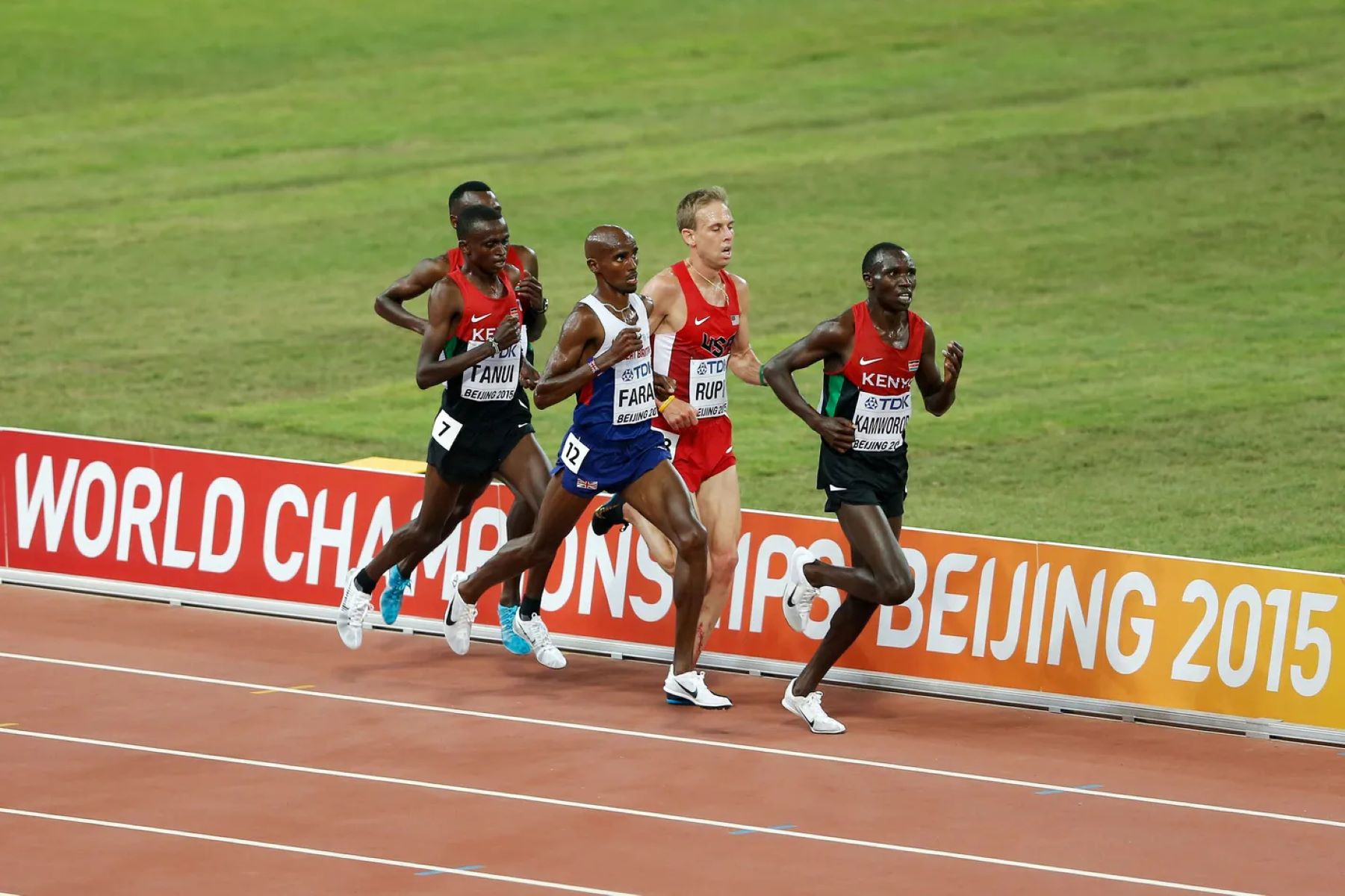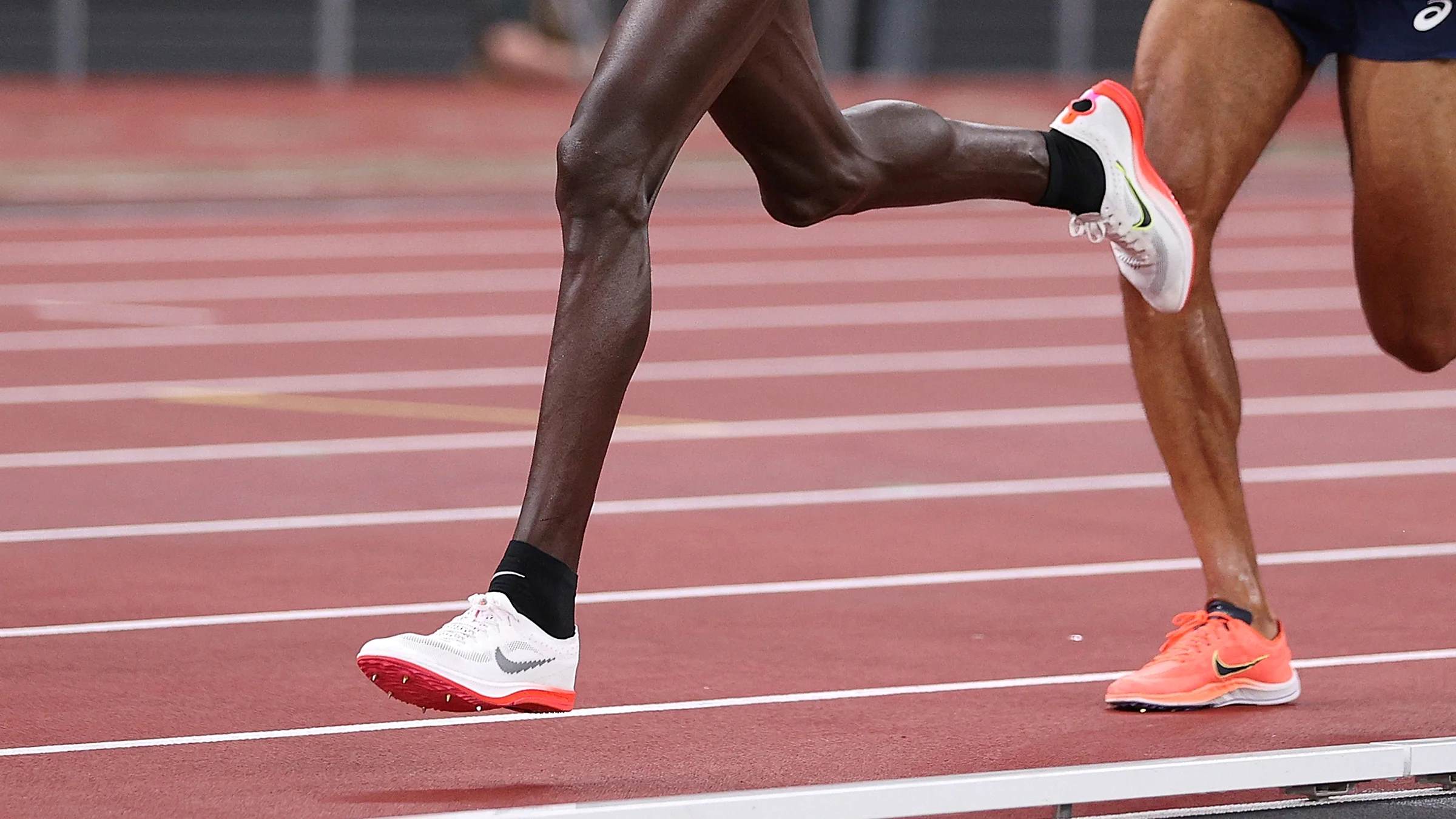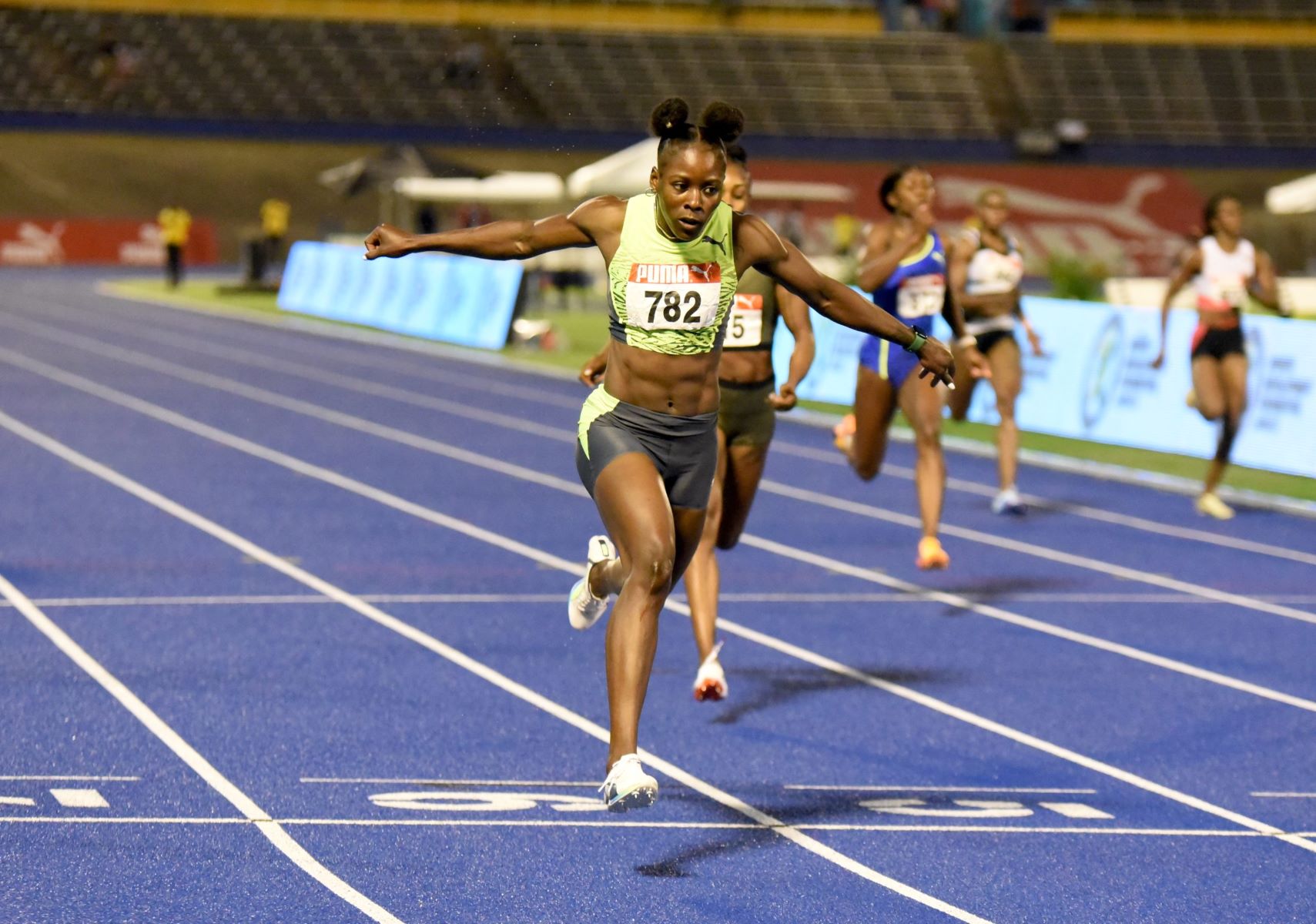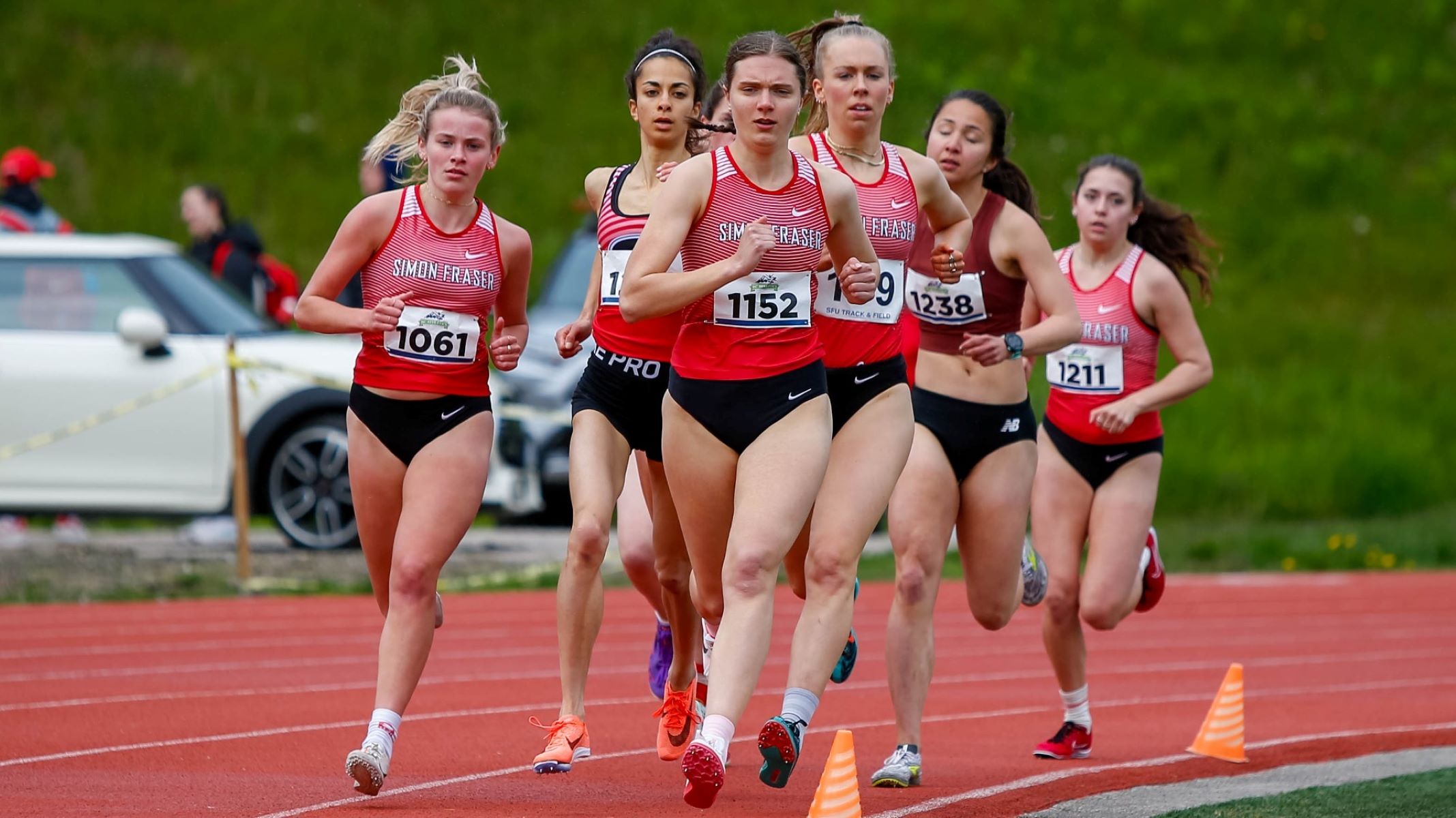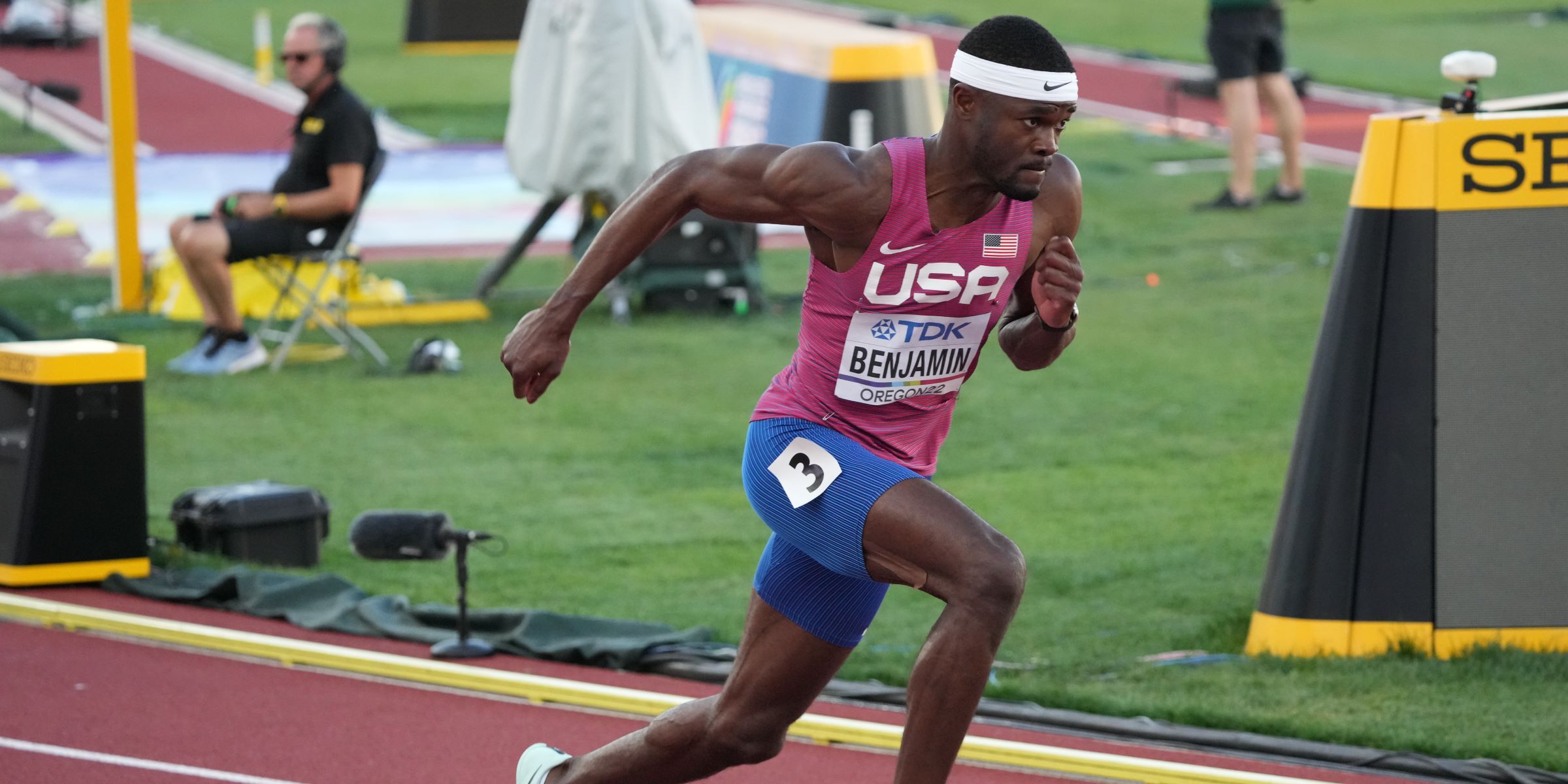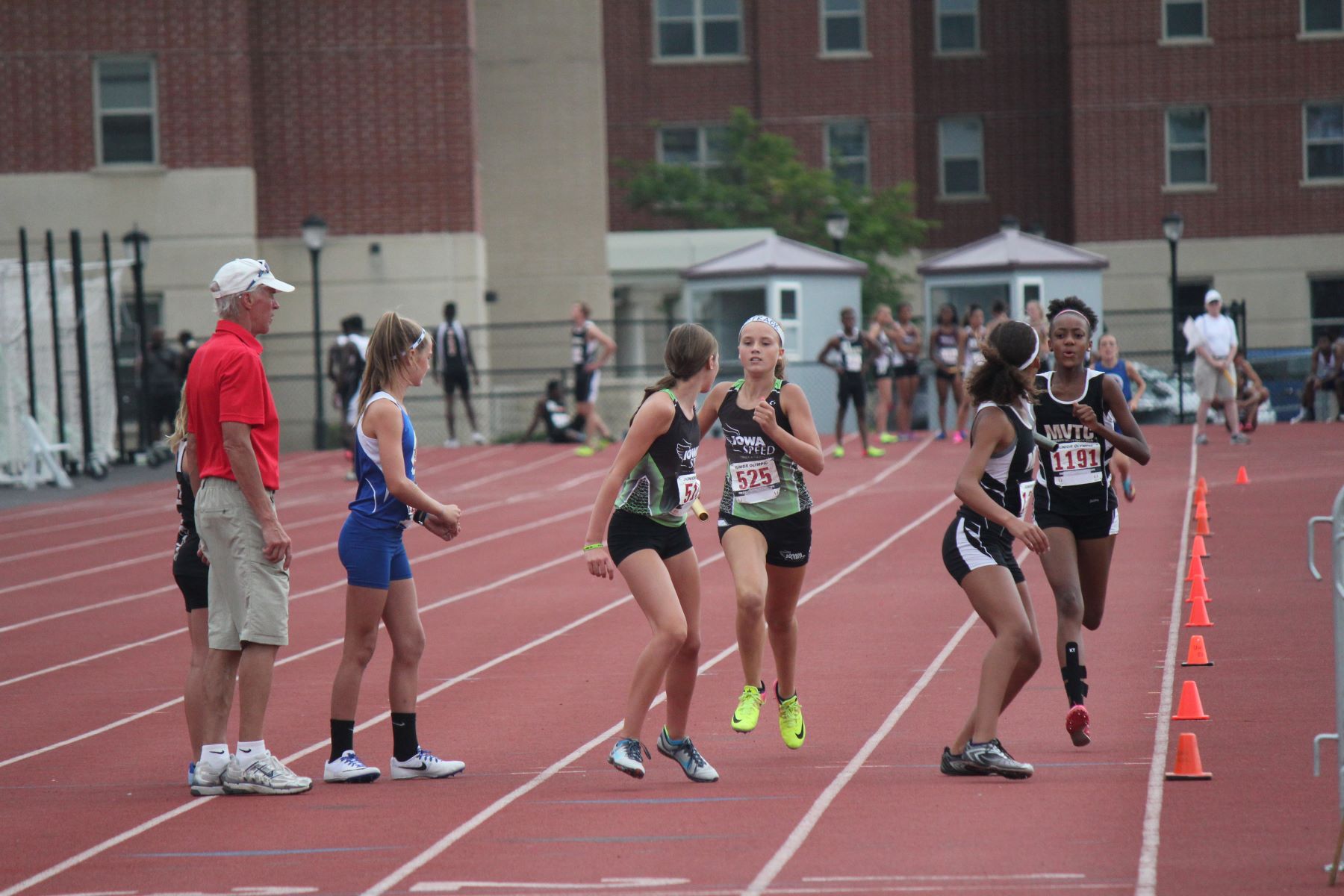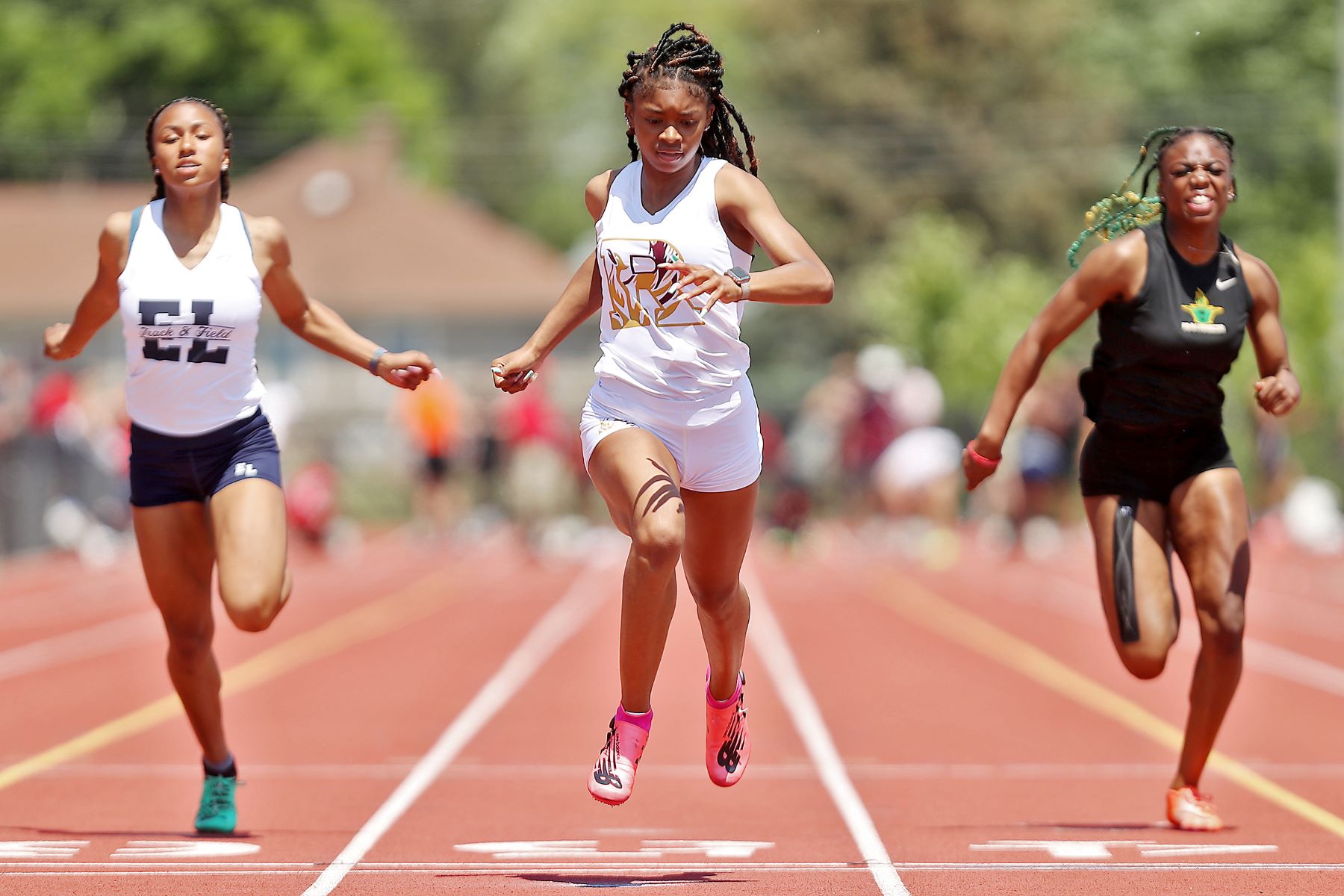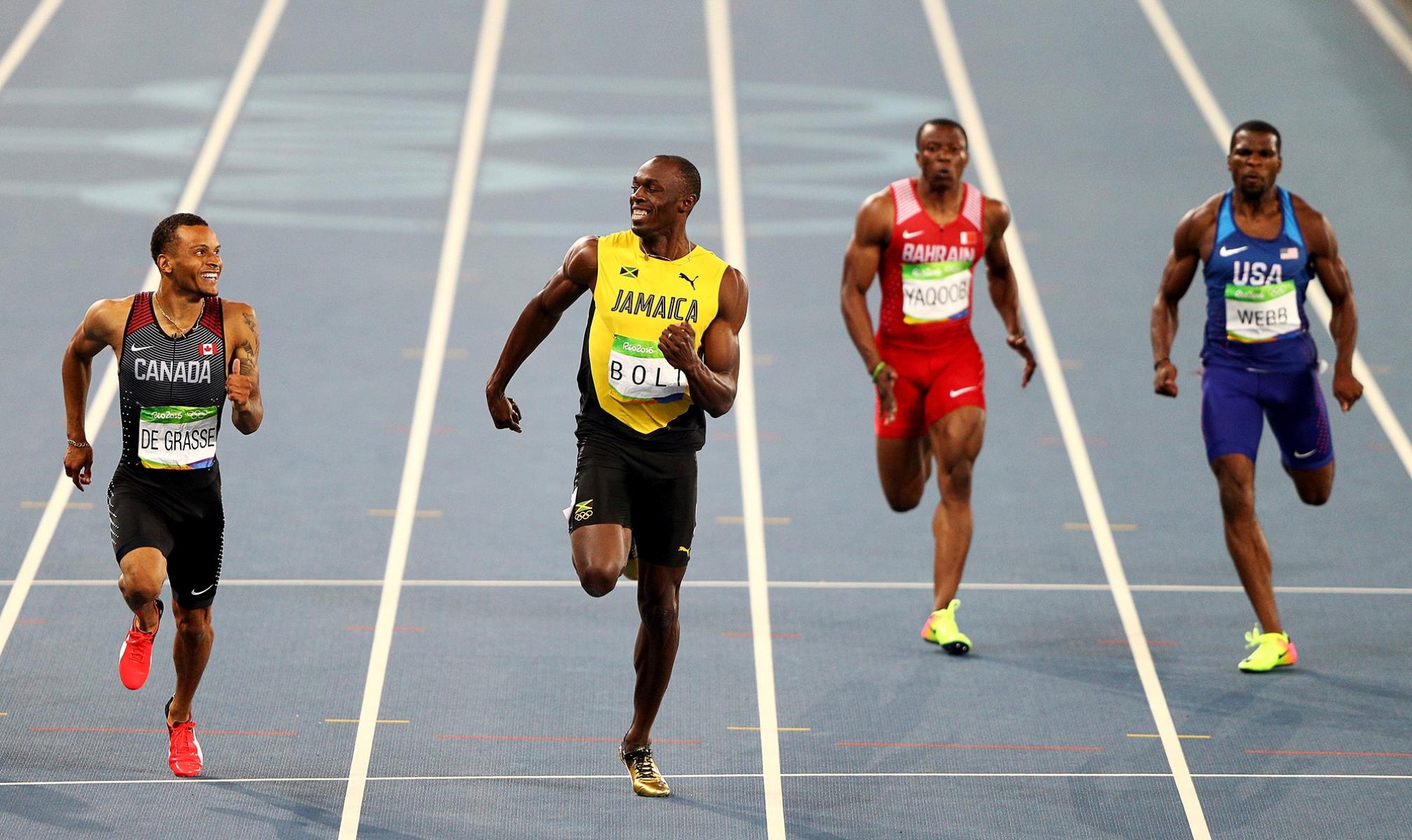

Featured
How To Train For 100M Sprint
Modified: January 22, 2024
Get the best tips and techniques to train for a 100M sprint race. Learn from the featured experts and reach your maximum speed and performance.
Introduction
Training for the 100-meter sprint is a challenging and exhilarating endeavor that requires dedication, discipline, and a strategic approach. Whether you’re a seasoned sprinter looking to improve your speed or a beginner looking to take on the challenge of mastering this explosive event, proper training is key to reaching your full potential.
Sprinting is one of the most exciting and dynamic sports, as it combines raw power, speed, and technique. The 100-meter dash is the shortest and fastest event in track and field, demanding athletes to explode off the starting blocks and maintain maximum velocity until they cross the finish line. To succeed in this demanding event, athletes must focus on developing their speed, power, agility, endurance, and mental fortitude.
In this comprehensive guide, we will delve into the essential aspects of training for the 100-meter sprint. We will explore the importance of training, provide insights into the fundamentals of sprinting, and outline key strategies to help you improve your performance.
Whether you’re an aspiring sprinter aiming to compete at the elite level or simply looking to improve your personal best, this article will equip you with the knowledge, skills, and training techniques you need to excel in the 100-meter sprint.
Importance of Training for 100M Sprint
Training is the foundation for success in any athletic endeavor, and the 100-meter sprint is no different. Proper and systematic training plays a vital role in helping athletes achieve their maximum potential and excel in this explosive event.
One of the key reasons why training is crucial for the 100-meter sprint is the development of speed. The ability to generate and sustain high velocity is the essence of sprinting. Through targeted training, athletes can improve their acceleration, top speed, and overall running mechanics.
Moreover, training for the 100-meter sprint helps athletes enhance their power and explosiveness. Sprinting requires a tremendous amount of power to generate the force necessary to propel the body forward. By incorporating strength and power exercises into their training regimen, sprinters can improve their muscle strength, explosiveness off the starting blocks, and overall athletic performance.
In addition to speed and power, training also focuses on agility and coordination. Sprinters need to have quick footwork, precise movements, and the ability to change direction efficiently. Agility drills and coordination exercises are integral in helping athletes develop these skills, which translate into improved performance on the track.
Endurance is another critical aspect of training for the 100-meter sprint. While it may seem counterintuitive to focus on endurance for such a short event, it’s important to note that stamina plays a key role in maintaining stride length and speed throughout the entire race. By incorporating interval training and other endurance-based exercises into their routine, sprinters can delay the onset of fatigue and finish strong.
Mental preparedness is often underestimated but is equally important in training for the 100-meter sprint. Sprinters need to have a strong mindset, mental resilience, and the ability to cope with pressure. Training not only strengthens the body but also builds mental toughness, focus, and confidence. Visualization exercises, goal setting, and psychological training help athletes develop the mental fortitude required to perform at their best on race day.
In summary, training for the 100-meter sprint is vital for maximizing athletic potential. By incorporating speed, power, agility, endurance, and mental training, athletes can enhance their performance, improve their race times, and achieve their goals on the track.
Understanding the Basics of Sprinting
Before diving into training for the 100-meter sprint, it’s important to understand the fundamental mechanics and principles of sprinting. A solid grasp of the basics will set the foundation for efficient and effective training, leading to improved performance on the track.
One of the primary components of sprinting is proper running form. Sprinters strive for a tall and upright posture, with their head and shoulders aligned and relaxed. The arms should move in a controlled and coordinated manner, driving forward and backward to generate momentum. The hips should stay aligned with the body, promoting efficient leg drive and stride length.
The start is a critical phase in sprinting, and mastering the technique can give athletes a significant advantage. The key elements of a powerful start include explosive leg drive, a quick and efficient transition from the crouched position to an upright stance, and a powerful first step. Practice starts from both blocks and standing starts to develop explosive power off the line.
Another crucial aspect of sprinting is stride length and frequency. Stride length refers to the distance covered with each step, while frequency is the number of strides per second. To achieve maximum speed, sprinters aim for long, powerful strides while maintaining a high turnover rate. Stride length and frequency can be improved through technique drills, strength training, and plyometric exercises.
In addition to proper form and technique, sprinters must also have a solid understanding of race strategy. While the 100-meter sprint is a short and explosive event, pacing and race execution are still crucial. Sprinters must determine when to exert maximal effort, when to accelerate, and when to maintain speed to ensure a strong finish. Analyzing race videos, studying opponents, and working with coaches can help develop effective race strategies.
It’s important to note that sprinting places significant stress on the body, especially the muscles and joints. Therefore, injury prevention is critical. Building a strong core, maintaining flexibility, and incorporating regular stretching into training routines can reduce the risk of common sprinting injuries. It’s also essential to listen to the body, rest when necessary, and seek proper medical attention when injuries occur.
In summary, a solid understanding of the basics of sprinting sets the stage for effective training and improved performance. By focusing on proper form, mastering the start, optimizing stride length and frequency, and developing race strategies, sprinters can enhance their athletic abilities and excel in the 100-meter sprint.
Setting Goals for 100M Sprint Training
Goal setting is a crucial step in any training program, and training for the 100-meter sprint is no exception. Setting specific, measurable, achievable, relevant, and time-bound (SMART) goals helps athletes stay focused, motivated, and accountable throughout their training journey.
First and foremost, establishing a clear performance goal is essential. This goal could be achieving a specific time, qualifying for a championship meet, or improving upon a personal best. Having a tangible target gives athletes something to strive for and provides direction for their training efforts.
Alongside performance goals, it’s important to set process-oriented goals. These goals focus on the specific actions and habits that contribute to improved performance. Examples of process-oriented goals for 100-meter sprint training may include increasing strength through regular weightlifting sessions, improving technique through form drills, or enhancing flexibility through dedicated stretching routines.
In addition to time-based goals, it’s beneficial to set short-term and long-term goals. Short-term goals provide immediate targets and help athletes track their progress on a regular basis. These goals may be accomplished within a few weeks or months and can serve as stepping stones towards larger, long-term goals. Long-term goals, on the other hand, extend beyond the immediate future and may span over several months or even years.
As part of goal setting, it’s important to make goals both challenging yet realistic. Pushing oneself beyond comfort zones is necessary for growth and improvement, but setting unattainable goals can quickly lead to frustration and demotivation. It’s crucial to find the right balance and ensure that goals are within reach with focused effort and dedicated training.
Setting both outcome goals and process goals is advantageous. Outcome goals, such as achieving a specific time or placement, provide a long-term vision and motivation. Process goals, on the other hand, focus on the steps and actions needed to achieve the desired outcome. Combining both types of goals helps athletes stay motivated on a day-to-day basis while working towards their ultimate targets.
Regularly reviewing and reassessing goals is also important. As athletes progress in their training, goals may need to be adjusted or modified. Regular check-ins with coaches, evaluating progress, and making necessary adjustments ensure that goals remain relevant and achievable.
In summary, setting goals for 100-meter sprint training is a critical component of a successful training program. By establishing SMART goals that are specific, measurable, achievable, relevant, and time-bound, athletes can stay focused, motivated, and track their progress on the journey to achieving their desired outcomes.
Warm-Up and Cool-Down Exercises
Proper warm-up and cool-down exercises are essential for any sprinter’s training regimen. These exercises not only prepare the body for intense physical activity but also aid in injury prevention and enhance overall performance. Incorporating dynamic warm-up exercises before a sprinting session and static stretches during the cool-down phase can significantly benefit sprinters.
Warm-up exercises serve to gradually increase heart rate, blood flow, and body temperature, preparing the muscles and joints for the demands of sprinting. A dynamic warm-up routine typically includes movements that mimic the actions and range of motion involved in sprinting. This may include exercises such as leg swings, high knees, butt kicks, and walking lunges.
In addition to general dynamic movements, it’s important to include sport-specific drills in the warm-up routine. This may include short sprints at reduced intensity, accelerations, and some low-intensity plyometric exercises. These drills help groove proper sprinting mechanics, activate the fast-twitch muscle fibers, and mentally prepare the sprinter for the upcoming training or race.
While warm-up exercises focus on dynamic movements, cool-down exercises involve static stretching to improve flexibility and promote muscle recovery. Static stretches are held for a specified duration, typically around 30 seconds, targeting major muscle groups used during sprinting, such as the hamstrings, quadriceps, and calves. This helps reduce muscle tension, increase flexibility, and prevent post-workout stiffness and soreness.
Additionally, cool-down exercises enable the body to gradually transition from high-intensity exercise to a resting state. This includes bringing the heart rate and breathing back to normal levels. Light aerobic exercises, such as jogging or cycling at a low intensity, can be incorporated into the cool-down routine to facilitate this process.
Foam rolling or self-myofascial release techniques are also beneficial during the cool-down phase. Rolling the muscles over a foam roller aids in releasing tension and improving circulation, promoting faster recovery and reducing muscle tightness.
It’s important to note that warm-up and cool-down exercises should be personalized based on individual preferences and needs. While there are general guidelines and exercises that apply to most athletes, each sprinter may have specific areas of focus or certain exercises that work best for them.
In summary, incorporating proper warm-up and cool-down exercises into a sprinter’s training routine is essential for injury prevention, performance enhancement, and overall recovery. A dynamic warm-up prepares the body for intense activity, while static stretching and light aerobic exercises during the cool-down phase help the body gradually return to a resting state and promote recovery.
Building Strength for Speed
Building strength is a crucial component of training for the 100-meter sprint. Improved strength not only enhances sprinter’s power output but also helps prevent injuries and supports overall speed development. Incorporating specific strength training exercises into the training program can lead to substantial improvements in sprinting performance.
One of the primary areas to focus on when building strength for speed is the lower body, especially the muscles involved in sprinting. Squats, lunges, and deadlifts are fundamental exercises that target the quadriceps, hamstrings, glutes, and calves, helping to develop the explosive power necessary for sprinting. These exercises can be performed with both bodyweight and added resistance, such as barbells, dumbbells, or resistance bands.
In addition to compound exercises, plyometric movements are highly effective in building strength and power for speed. Exercises like box jumps, bounding drills, and single-leg hops improve explosive strength and improve the ability to generate force quickly. These exercises mimic the explosive nature of sprinting and help train the nervous system to fire rapidly to achieve maximum power output.
Core strength is another critical aspect of building overall strength for speed. A strong core stabilizes the body and transfers force efficiently from the upper body to the lower body during sprinting. Incorporating exercises such as planks, Russian twists, and medicine ball throws can help develop a strong and stable core, improving sprinting performance and reducing the risk of lower back injuries.
It’s important to note that strength training should not solely focus on lifting heavy weights. Developing strength endurance is equally important for sprinters. This can be achieved through circuit training or high-intensity interval training (HIIT) workouts that combine strength exercises with cardiovascular elements. These types of workouts mimic the demands of sprinting, improving muscular endurance, while still building strength and power.
Alongside strength training, it’s essential to prioritize proper technique and form during exercises. Sprinters should ensure they maintain proper body alignment and execute exercises with control and precision to maximize their benefits and reduce the risk of injury.
Lastly, adequate rest and recovery are crucial for strength development. Strength training places stress on the muscles and connective tissues, and proper rest allows time for adaptation and growth. Incorporating rest days into the training program and ensuring sufficient sleep and nutrition are essential for maximizing the benefits of strength training.
In summary, building strength is essential for enhancing speed and performance in the 100-meter sprint. Incorporating exercises that target the lower body, plyometric movements, and core strength training helps sprinters develop the explosive power and muscular endurance necessary for sprinting. Combined with proper technique and adequate rest, strength training can make a significant impact on sprinting performance.
Speed and Agility Training Techniques
Speed and agility are critical components of success in the 100-meter sprint. Developing these qualities requires targeted training techniques that improve quickness, reaction time, and overall athletic performance. Incorporating specific speed and agility training exercises and drills into the training program can help sprinters optimize their performance on the track.
One effective method for improving speed and agility is through sprint interval training. This involves performing short, maximum effort sprints followed by brief periods of rest or active recovery. Sprint intervals not only enhance anaerobic power and speed but also improve cardiovascular fitness. Examples of sprint interval training can include running 30-meter sprints at maximum effort followed by 30 seconds of recovery jogging or walking.
Another valuable training technique is overspeed training. This involves using external aids such as bungee cords, sleds, or downhill sprints to create resistance or assistance, respectively, to the sprinter. Overspeed training helps to improve stride frequency, stride length, and neuromuscular coordination—leading to improvements in top-end speed.
Agility ladder drills are also beneficial for enhancing speed and agility. The agility ladder is a tool consisting of a ladder-like structure that athletes use to perform various footwork patterns and quick directional changes. These drills improve foot speed, coordination, and the ability to change direction rapidly—key components of agility required for the 100-meter sprint.
Cone drills are another effective way to improve speed and agility. By setting up cones in various formations and distances, sprinters can practice quick acceleration, deceleration, lateral movements, and changes of direction. Cone drills simulate the unpredictable nature of sprinting and help athletes react quickly to different scenarios.
Another valuable speed and agility training technique is hill sprints. Running uphill forces the body to work against gravity, developing power and strength in the lower body. Hill sprints improve explosiveness, stride length, and overall running mechanics. Sprinters can perform hill sprints of various distances and inclines to challenge themselves and progressively enhance their speed and agility.
Finally, incorporating plyometric exercises into training can further improve speed and agility. Plyometric exercises involve explosive movements that develop power and increase the rate of force production. Examples of plyometric exercises include squat jumps, tuck jumps, and bounding. These exercises improve leg power, reactive strength, and the ability to generate force quickly—essential for sprinting at high speeds.
It’s important to note that speed and agility training should be tailored to individual needs and training levels. Progress should be gradual, and exercises should be performed with proper form and technique to reduce the risk of injury. It’s also essential to incorporate sufficient rest and recovery to allow the body to adapt and grow stronger.
In summary, incorporating speed and agility training techniques into the training program for the 100-meter sprint is crucial for optimizing performance. Sprint interval training, overspeed training, agility ladder drills, cone drills, hill sprints, and plyometric exercises are effective methods for enhancing speed, agility, and overall athletic performance. By incorporating these techniques into training, sprinters can become faster, more agile, and better prepared for the demands of the 100-meter sprint.
Plyometric Exercises for Explosiveness
Plyometric exercises are an essential component of training for the 100-meter sprint. These exercises involve powerful, explosive movements that focus on rapid stretching and contracting of the muscles, enhancing muscular power, and improving overall explosiveness. By incorporating plyometric exercises into their training routine, sprinters can increase their ability to generate force quickly and improve their sprinting performance.
One of the most effective plyometric exercises for explosiveness is box jumps. Box jumps involve jumping onto a sturdy box or platform from a standing position and then immediately jumping back down or stepping off the box. This exercise targets the leg muscles and develops explosive power in the lower body, helping sprinters generate force efficiently and improving their ability to accelerate off the ground.
Another valuable plyometric exercise is depth jumps. Depth jumps involve stepping off a high platform and immediately exploding upward upon landing, aiming to achieve maximum height with each jump. This exercise focuses on improving reactive strength and the stretch-shortening cycle of the muscles, enabling sprinters to generate optimal power and speed during the push-off phase of running.
Skipping exercises, such as single-leg bounding or double-leg skipping, are also effective plyometric exercises for explosiveness. These exercises improve the coordination and timing of movements, enhance muscular power, and boost stride length. By incorporating skipping exercises into their training routine, sprinters can improve their explosiveness and develop a more efficient and powerful running stride.
Squat jumps are another beneficial plyometric exercise that can significantly enhance explosiveness. Squat jumps involve performing a deep squat and then explosively jumping off the ground, reaching maximum height with each jump. This exercise targets multiple muscle groups, including the quadriceps, hamstrings, and glutes, improving lower body power and enhancing the ability to generate force during sprinting.
Medicine ball throws can also be incorporated into plyometric training for explosive power. Exercises such as overhead medicine ball throws or chest passes involve explosive movements that engage the upper body muscles, including the shoulders, chest, and triceps. These exercises improve upper body power, which is crucial for maintaining proper arm and shoulder action during sprinting.
When incorporating plyometric exercises into a training program, it’s essential to start with proper technique and progress gradually. Plyometric exercises place high demands on the muscles and joints, so it’s crucial to ensure that the athlete has a solid strength foundation, appropriate conditioning, and a good understanding of proper form before engaging in these exercises.
It’s also important to consider recovery and rest intervals when incorporating plyometric exercises. These exercises are high-intensity and place significant stress on the body. Providing adequate rest between plyometric sessions and incorporating recovery strategies such as foam rolling, stretching, and proper nutrition can aid in preventing overuse injuries and optimizing gains in explosiveness.
In summary, incorporating plyometric exercises into the training routine is essential for developing explosiveness in sprinters. Exercises such as box jumps, depth jumps, skipping exercises, squat jumps, and medicine ball throws target different muscle groups and improve power and explosiveness. By incorporating these exercises safely and progressively, sprinters can enhance their ability to generate force quickly and ultimately improve their performance in the 100-meter sprint.
Endurance Training for 100M Sprint
While the 100-meter sprint is a short and explosive event, it still requires a certain level of endurance to maintain speed and power throughout the race. Endurance training plays a crucial role in improving stamina, delaying the onset of fatigue, and ensuring a strong finish. Incorporating specific endurance training techniques into the training program can help sprinters optimize their performance in the 100-meter sprint.
One effective method of endurance training for sprinters is interval training. Interval training involves alternating between periods of high-intensity effort and periods of active recovery. For the 100-meter sprint, intervals can be tailored to mimic the demands of the event by performing short, intense sprints followed by periods of lower-intensity jogging or walking. This type of training improves the efficiency of energy systems, enhances anaerobic capacity, and delays the onset of lactic acid buildup.
Another valuable approach to endurance training is tempo runs. Tempo runs are performed at a comfortably hard pace, just below the sprinting intensity, for a continuous period of time. These runs typically last for several minutes and are aimed at improving aerobic capacity and muscular endurance. Tempo runs enhance the ability to maintain a strong pace, improve oxygen utilization, and delay the onset of fatigue during the 100-meter sprint.
Longer aerobic runs can also be incorporated into endurance training for sprinters, although they should be done in moderation. These runs help build a strong aerobic base, improve cardiovascular fitness, and enhance overall endurance. However, it is important to strike a balance, as excessive aerobic training may lead to a loss of explosiveness and negatively impact sprinting performance.
Additionally, incorporating circuit training or high-intensity interval training (HIIT) workouts into the training routine can improve both endurance and speed. These workouts combine cardiovascular exercises with strength exercises performed in a fast-paced, alternating manner. This type of training helps improve muscular endurance, cardiovascular fitness, and the ability to sustain high-intensity efforts throughout the race.
Proper rest and recovery are essential components of endurance training for sprinters. Overtraining can lead to fatigue, decreased performance, and an increased risk of injury. Integrating rest days into the training program, managing training volume and intensity, and ensuring adequate sleep and nutrition are vital for optimizing gains in endurance.
Incorporating specific endurance training into the overall training program for the 100-meter sprint can have a significant impact on overall performance. By improving stamina, delaying fatigue, and maintaining speed, sprinters can maximize their potential and achieve their best results in the race.
Proper Sprinting Form and Technique
Proper sprinting form and technique are crucial for maximizing speed, efficiency, and overall performance in the 100-meter sprint. The right technique allows sprinters to optimize their stride length, stride frequency, and biomechanics, resulting in faster and more efficient running. Incorporating key elements of proper sprinting form into the training regimen can significantly enhance sprinting ability.
One of the fundamental aspects of sprinting form is body alignment. Sprinters should strive for an upright posture with a slight forward lean. The head should be neutral and relaxed, the shoulders should be aligned and not hunched, and the arms should swing in a controlled and coordinated motion. Proper body alignment ensures efficient energy transfer and allows for optimal leg movement and stride length.
The foot strike is another crucial component of sprinting technique. Sprinters should aim to strike the ground with the balls of their feet, rolling through to the toes, to generate maximum force and push off effectively. Landing on the heels can lead to braking action and reduce overall speed. Proper foot strike mechanics can be improved through drills and exercises that emphasize mid-foot or forefoot striking.
Leg drive is essential for generating power and propelling the body forward during sprinting. Sprinters should focus on driving their knees upwards and forwards, creating a powerful leg extension and push-off. Proper leg drive helps maximize stride length and stride frequency. Plyometric exercises, strength training exercises, and ladder drills can all help improve leg drive and develop explosive power.
Arm action is often overlooked but plays a critical role in sprinting form. The arms should swing in a controlled and coordinated manner, with elbows at approximately 90 degrees. The arm swing should be forward and backward, helping to generate momentum and balance the lower body movement. Proper arm action aids in maintaining balance, rhythm, and overall efficiency.
Effective sprinting also requires a strong and stable core. A strong core provides stability and helps transfer force efficiently from the upper body to the lower body, allowing for powerful leg drive and optimal running mechanics. Core exercises such as planks, Russian twists, and medicine ball throws can help develop core strength and stability for improved sprinting form.
It’s important to remember that mastering proper sprinting form and technique takes practice and attention to detail. Incorporating form drills into the warm-up routine, analyzing race videos, and working with a coach can all help identify areas for improvement and make the necessary adjustments to sprinting technique.
Furthermore, it’s important to note that sprinting form is highly individualized. Different athletes may have variations in body types, mechanics, and strengths. It’s crucial to find the form and technique that works best for each athlete while still adhering to the key principles of proper sprinting form.
In summary, proper sprinting form and technique are vital for maximizing speed, efficiency, and overall performance in the 100-meter sprint. Focusing on body alignment, foot strike mechanics, leg drive, arm action, and core stability can significantly enhance sprinting ability and lead to improved results on the track.
Injury Prevention and Recovery Strategies
As with any high-intensity sport, injury prevention and recovery are paramount in training for the 100-meter sprint. Sprinting puts significant stress on the muscles, joints, and connective tissues, increasing the risk of injuries such as strains, sprains, and muscle imbalances. By incorporating proper injury prevention strategies and implementing effective recovery techniques, sprinters can minimize the risk of injuries and optimize their performance.
One of the key components of injury prevention is a proper warm-up routine. A dynamic warm-up prepares the body for intense physical activity by increasing blood flow, loosening up the muscles, and enhancing joint mobility. It often includes exercises such as leg swings, hip rotations, and arm circles. Investing time in a thorough warm-up can help reduce the risk of muscle strains and enhance overall performance.
Another crucial aspect of injury prevention is strength training. Building strength in the muscles and connective tissues helps support the body during explosive movements and reduces the strain on vulnerable areas. Incorporating exercises that target the muscles used during sprinting, such as squats, lunges, and hamstring curls, can help improve muscular strength and stability.
Proper technique and form during sprinting are also vital for injury prevention. Maintaining proper body alignment, using the correct foot strike mechanics, and ensuring efficient arm action can reduce the risk of overuse injuries and improve overall efficiency. Working with a coach or experienced sprinter can provide valuable feedback and guidance on technique correction.
Recovery strategies play an equally important role in injury prevention and overall performance. Adequate rest is crucial for allowing the body to repair and rebuild after intense training sessions. Sprinters should ensure they are getting enough sleep to facilitate recovery and optimize their training gains.
In addition to rest, nutrition also plays a significant role in recovery. Proper fueling before and after training sessions is important to provide the nutrients needed for muscle repair and growth. Eating a balanced diet that includes a mix of carbohydrates, protein, and healthy fats can support recovery and promote overall health.
Active recovery techniques, such as gentle stretching, foam rolling, and mobility exercises, can also aid in the recovery process. These practices help increase blood flow, reduce muscle soreness, and improve flexibility, allowing sprinters to recover faster and perform better in subsequent training sessions.
Listening to the body and recognizing the signs of fatigue or potential injury is essential. Pushing through pain or ignoring warning signs can lead to more severe injuries and longer recovery periods. If sprinters experience pain, discomfort, or unusual symptoms, they should seek proper medical attention, consult with a healthcare professional, and follow the recommended treatment plan.
Lastly, gradually progressing training volume and intensity is crucial for injury prevention. Gradually increasing training load allows the body to adapt and helps avoid overuse injuries. Monitoring training load, incorporating rest days into the training program, and listening to the body’s signals are key in preventing injuries and promoting long-term athletic success.
In summary, proper injury prevention strategies and effective recovery techniques are vital for sprinters in the 100-meter event. Incorporating a thorough warm-up routine, strength training exercises, proper technique, rest and recovery practices, and gradual progression can help minimize the risk of injuries and optimize sprinting performance.
Mental Preparation for 100M Sprint
Mental preparation is a critical aspect of training for the 100-meter sprint. The physical demands of the event are matched by the mental challenges that sprinters must overcome. Developing a strong mental game can greatly enhance focus, confidence, and overall performance on the track. Incorporating specific mental preparation techniques into the training routine can help sprinters optimize their mental approach and achieve their full potential.
One of the first steps in mental preparation is goal setting. Sprinters should establish clear, specific, and attainable goals for their performance in the 100-meter sprint. These goals provide direction, motivation, and a target to strive for. Setting both outcome goals, such as achieving a specific time or placement, and process goals, such as improving technique or mental focus, allows sprinters to track their progress and stay engaged in the training process.
Visualization is a powerful tool in mental preparation for sprinting. Athletes can imagine themselves performing at their best, visualize the race from start to finish, and mentally rehearse their form, technique, and strategies. By repeatedly visualizing success, sprinters can build confidence, reinforce positive thoughts, and develop a mental blueprint for optimal performance on race day.
Positive self-talk is another powerful technique that can influence performance. Sprinters should focus on building an internal dialogue that is constructive, encouraging, and supportive. By replacing negative thoughts or doubts with positive affirmations and self-belief, sprinters can develop a resilient mindset and maintain confidence in their abilities.
Managing pre-race nerves and anxiety is crucial for sprinters. Utilizing relaxation techniques, such as deep breathing exercises or mindfulness meditation, can help calm the mind and reduce stress levels. Establishing a pre-race routine that includes specific actions or rituals can also provide a sense of familiarity and comfort, helping sprinters get into the right mindset before stepping onto the track.
Focusing on the present moment, also known as being present-centered, is essential during the 100-meter sprint. Sprinters should aim to stay fully engaged and focused on each phase of the race, from the start to the finish line. By channeling their attention and energy into the present moment, sprinters can optimize their reaction time, technique, and overall performance.
Dealing with setbacks and adversity is a part of any competitive sport, including sprinting. Developing resilience and the ability to bounce back from setbacks is crucial. Sprinters should view setbacks as learning opportunities, adapt their approach when necessary, and maintain a growth mindset. The ability to handle setbacks with a positive attitude and persistence is a key attribute of mentally strong sprinters.
Finally, working with a sports psychologist or mental performance coach can provide valuable guidance and support in mental preparation for the 100-meter sprint. These professionals can help identify individual strengths and areas for improvement, provide strategies tailored to specific needs, and offer support in managing the mental aspects of competing at a high level.
In summary, mental preparation is integral to success in the 100-meter sprint. Goal setting, visualization, positive self-talk, relaxation techniques, staying present-centered, resilience, and seeking professional support are all important components of mental preparation. By incorporating these techniques into their training routine, sprinters can optimize their mental approach and perform at their best on race day.
Nutrition and Hydration for Sprinters
Nutrition and hydration play a vital role in supporting performance and recovery for sprinters in the 100-meter event. Proper fueling and hydration strategies are crucial for optimizing energy levels, supporting muscle function, and overall athletic performance. Incorporating specific nutritional guidelines into the training program can help sprinters maximize their potential on the track.
One of the key considerations for sprinters is maintaining adequate energy levels. Sprinting is a high-intensity activity that requires quick bursts of energy. Carbohydrates are the primary source of fuel for sprinters’ muscles. Incorporating carbohydrate-rich foods such as whole grains, fruits, vegetables, and legumes into each meal helps ensure an adequate glycogen stores, providing readily available energy during training and competition.
Protein is crucial for muscle recovery and repair. Sprinters should ensure they are consuming enough high-quality protein sources, such as lean meats, fish, poultry, dairy, eggs, and plant-based protein sources like beans, lentils, and tofu. Protein intake should be spread out throughout the day to optimize muscle protein synthesis and aid in recovery.
Hydration is also essential for sprinters. Dehydration can significantly impair performance and lead to fatigue and muscle cramps. It’s important to drink fluids regularly throughout the day and stay hydrated during training sessions and races. Monitoring hydration levels through urine color and ensuring adequate fluid intake can help prevent dehydration.
Electrolyte balance is critical for sprinters to maintain proper muscle contraction and nerve function. Replacing electrolytes lost through sweat, such as sodium, potassium, and magnesium, is important. Sports drinks or electrolyte-rich beverages can be consumed during intense training sessions or competitions to replace these essential minerals.
Timing of meals and snacks is also important. Sprinters should aim to consume a balanced meal or snack containing carbohydrates and protein within two to four hours before training or competition. This allows adequate time for digestion and absorption, providing a source of consistent energy during the sprinting event.
During training, especially intense or prolonged sessions, consuming easily digestible carbohydrates, such as sports drinks, gels, or fruit, can help maintain energy levels and delay fatigue. Post-workout or post-race nutrition is crucial for recovery. Consuming a combination of carbohydrates and protein within 30 minutes of ending the session can help replenish glycogen stores, repair damaged muscles, and enhance recovery.
It’s important for sprinters to pay attention to individual nutritional needs and preferences. Experimenting with different food choices and listening to the body’s hunger and fullness cues is crucial. Consulting with a registered dietitian who specializes in sports nutrition can provide tailored guidance and support for individualized nutrition plans.
In summary, proper nutrition and hydration are essential for sprinters in the 100-meter event to optimize performance and recovery. Balancing carbohydrates, protein, and hydration, and consuming adequate calories to support training and competition are key. By incorporating these nutritional strategies into their training routine, sprinters can fuel their bodies for optimal performance on the track.
Sample Training Plan for 100M Sprint
A well-structured training plan is essential for sprinters preparing for the 100-meter event. This sample training plan incorporates a combination of speed training, strength training, endurance training, and rest days to optimize performance and overall athletic development. This plan is a general guideline that can be adjusted based on individual needs, goals, and training level.
Week 1:
- Monday: Rest day, focus on recovery and mobility exercises.
- Tuesday: Speed training. Perform 8-10 sets of 30-meter sprints at maximum effort with full recovery between sets.
- Wednesday: Strength training. Focus on compound exercises such as squats, deadlifts, and lunges, aiming for 3-4 sets of 6-8 reps.
- Thursday: Endurance training. Perform a 20-minute tempo run at a comfortably hard pace, just below the sprinting intensity.
- Friday: Rest day, focus on active recovery such as light stretching or foam rolling.
- Saturday: Speed and agility training. Incorporate cone drills and ladder drills to improve quickness, agility, and change of direction.
- Sunday: Long aerobic run. Aim for a 30-45 minute run at a conversational pace to build cardiovascular endurance.
Week 2:
- Monday: Rest day, focus on recovery and mobility exercises.
- Tuesday: Speed training. Perform 6-8 sets of 60-meter sprints at high intensity with full recovery between sets.
- Wednesday: Strength training. Include exercises targeting upper body muscles and core stability in addition to lower body exercises.
- Thursday: Endurance training. Perform intervals of 200-meter runs at 80% effort, followed by 1 minute of active recovery. Repeat 6-8 times.
- Friday: Rest day, focus on active recovery and flexibility exercises.
- Saturday: Plyometric training. Incorporate box jumps, squat jumps, and bounds to improve explosive power and leg strength.
- Sunday: Long aerobic run. Increase the duration to 45-60 minutes to continue building cardiovascular endurance.
Week 3:
- Monday: Rest day, focus on recovery and mobility exercises.
- Tuesday: Speed training. Perform 4-6 sets of 100-meter sprints at maximum effort, focusing on maintaining proper form and technique.
- Wednesday: Strength training. Increase resistance or weight for lower body exercises to continue building strength and power.
- Thursday: Endurance training. Perform 400-meter intervals at 70-80% effort, with 2-3 minutes of active recovery between intervals. Repeat 4-6 times.
- Friday: Rest day, focus on active recovery and mental preparation techniques.
- Saturday: Speed and agility training. Incorporate ladder drills, cone drills, and reaction drills to improve speed, quickness, and coordination.
- Sunday: Long aerobic run or low-intensity cross-training activity for active recovery, such as swimming or cycling.
Week 4:
- Monday: Rest day, focus on recovery and mobility exercises.
- Tuesday: Speed training. Perform 4-6 sets of 60-meter sprints at maximum effort, aiming for consistency and improving start technique.
- Wednesday: Strength training. Emphasize power exercises such as jump squats or power cleans to enhance explosive power.
- Thursday: Endurance training. Perform a 15-minute tempo run at a comfortably hard pace, focusing on maintaining speed and form.
- Friday: Rest day, focus on mental preparation and visualizing successful race scenarios.
- Saturday: Plyometric training. Incorporate depth jumps and reactive drills to improve reactive strength and explosiveness.
- Sunday: Pre-competition day. Perform light aerobic exercises, dynamic stretching, and mental imagery exercises to prepare for upcoming race events.
This sample training plan provides a general structure for a four-week training cycle. Sprinters should remember to listen to their bodies, adjust training intensity as needed, and prioritize rest and recovery for optimal performance. Consulting with a coach or sports professional can help customize this training plan based on individual abilities and goals.
Conclusion
Training for the 100-meter sprint is a multifaceted journey that requires a combination of physical and mental preparation. From developing speed, strength, and endurance, to honing proper form and technique, every aspect is integral to achieving success on the track. Incorporating a comprehensive and structured training plan, along with a focus on nutrition, hydration, injury prevention, and mental preparation, is key to optimizing performance and reaching one’s full potential.
Through targeted speed and agility training, sprinters can improve their explosiveness, quickness, and change of direction abilities. Strength training enhances power, stability, and overall athletic performance. Endurance training, although the 100-meter sprint is brief, builds stamina, delays fatigue, and supports a strong finish. Proper sprinting form and technique, including body alignment, foot strike, leg drive, and arm action, enable sprinters to maximize efficiency and speed.
Off the track, nutrition and hydration play vital roles in providing energy, supporting muscle recovery, and optimizing performance. Adequate rest and recovery strategies allow the body to adapt, grow stronger, and prevent injuries. Mental preparation techniques, such as goal setting, visualization, and positive self-talk, contribute to focus, confidence, and resilience.
A well-organized and tailored training plan, combined with attention to nutrition, hydration, injury prevention, and mental preparation, sets the foundation for success in the 100-meter sprint. However, it’s important to note that each sprinter is unique, and individual adjustments may be necessary. Consulting with a coach or sports professional can provide personalized guidance and support throughout the training journey.
Ultimately, training for the 100-meter sprint is a challenging yet rewarding pursuit. With dedication, discipline, and a comprehensive approach, sprinters can confidently step onto the track, knowing they have put in the necessary effort to maximize their potential and achieve their goals. The 100-meter sprint showcases the culmination of hard work, skill, and determination, making it one of the most thrilling and exhilarating events in the world of athletics.
